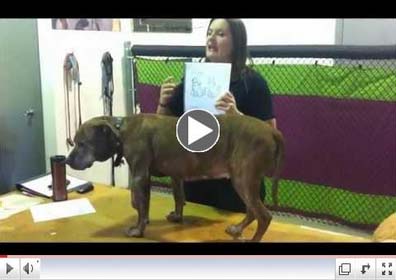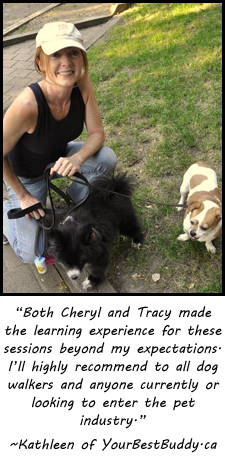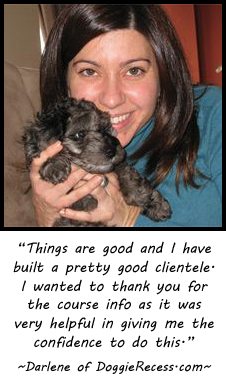Providing your pet with the very best, includes their health. As our pets get older, they will often develop what I lovingly call, Lumps and Bumps or Old Dog Bumps.
Since they are so common, this week we have both a lesson and an assignment.
Below the video, is a recap, and your assignment.
CLICK to PLAY the video below and learn how to recognize, and record, these changes, as they happen to your pet.
| Lumps and Bumps: Wellness Mapping for Your Pet |
Lumps and Bumps: Wellness Mapping for Your Pet
There are some generalizations that can be made about lumps and bumps on pets, yet one must realize that nothing is certain. All lumps and bumps should be checked out by a Veterinarian.
Generally speaking, lumps and bumps that grow quickly are the ones to be most concerned about. This is why Wellness Mapping is so important. Mapping lumps allows you to know, unequivocally, if a lump is changing or growing, how fast, or if at all.
To see pictures of the lumps and bumps, click on any of the names below.
Not all lumps and bumps are about aging. Some can be found on dogs of a young age:
Canine Papilloma – Also know as puppy warts, usually occurs in dogs under 2 years of age. This is characterized by cauliflower-like growths, usually found within or around the mouth, and often on the lips or inside the cheeks in groupings. They generally disappear within 6-8 weeks, therefore there is usually no need for treatment, unless they are interfering with eating or breathing.
Histiocytoma – A raised, hairless, roundish lump that sometimes appears literally overnight, and often on young dogs. Despite it’s quick appearance, it is generally benign (not cancerous), and does not grow larger after it has appeared. It will usually disappear within 2 to 3 months on it’s own, without treatment, however there are other varieties that can be malignant (cancerous), so it’s best to get it checked out by your Vet.
Often as dogs and cats get older, we will find different kinds of lumps and bumps appear:
Fatty lumps or Lipomas – These generally feel soft to the touch, painless and are often movable. They are slow growing and most usually benign (not cancerous). Although generally not something to worry about, there are more rare forms that are malignant, therefore your Vet may want to test it, and will likely ask you to watch the lump and inform them if the lump starts growing quickly.
Warts – These are also caused by the papilloma virus, however show up when a pets immune system has been compromised (often due to age). Considered benign, they are most commonly found on the feet and legs, but can be found anywhere on the body. They tend to start small and stay small, however others slowly grow larger over time. Generally speaking, these warts do not require treatment to remove, however they may bleed occasionally due to a scratch or being rubbed. Again, there are rare varieties that are malignant (cancerous), so if you notice fast growth or change in colour or shape, then consult your Vet.
Dogs and Cats of any age can be susceptible to the following types of lumps and bumps:
Sebaceous Cysts/Adenomas – Small non-painful lumps, caused by the plugging of an oil gland. These lumps generally rupture by themselves, drain and disappear. Sometimes they can become irritated or infected, and require draining and/or removal, but they are generally considered benign (not cancerous).
Neoplasms/Mast Cell Tumors/Cancerous Tumors – These are the tumours that are of concern. Often times they will seem more attached to the body and surrounding tissue, since they tend to be invasive, however, they can vary widely in shape, size, texture and appearance. (Thus the reason for no link to a picture… there are just too many varieties.) Generally speaking, malignant tumors tend to grow fast, since that is exactly what cancer is… cells that have begun dividing uncontrollably. The only way even a Vet can tell for sure, is to do a test to see what type of cells are in the tumor. Remember, the earlier the detection, the more options you have for treatment, and the better the prognosis… so make your appointment and head in to see your Vet.
Fibrosarcomas – Pay particular attention to the vaccine site. Lumps do commonly happen after a vaccine is given, however should go away within 1 to 2 weeks. If, however, the lump feels firm and remains or grows larger, have it checked out immediately by your Vet. Fibrosarcomas (cancerous lumps) are more common in cats, than dogs, however can appear in either. They are as a result of the vaccinations, therefore it is recommended that you request that your Vet inject vaccines into the hip area rather than the shoulder blades. Should a sarcoma develop, this will allow for a better chance of removal.
 Your Video Assignment – Four Easy Step to Creating a Map for your Pet
Your Video Assignment – Four Easy Step to Creating a Map for your Pet
Step 1: Gather Materials
- Ruler
- Camera (optional)
- Pen/Pencil and Marker
- Wax paper or plastic wrap
- Map for your pet – You can print from these links: Click here for Cats Click here for Dogs
Step 2: Give your Pet a Thorough Pat-Down to Map Their Body
- Body – back, sides, belly,
- Extremities – hips/shoulders, legs, feet, between pads/toes
- Tail & Privates
- Head – includes gums, teeth, eyes, ears, nostrils
Step 3: Record and Date Findings
- Above Skin lumps & bumps
- Below Skin lumps & bumps
- Differently coloured skin
- Missing hair
- Anything else you don’t recall seeing before
- Measure, Record & Date all findings
Step 4: Consult with Vet
Be sure to mark your calendar for regular and consistent re-checks.
Now you can feel confident that you know every inch of your pet. By having a Wellness Map, you are giving yourself peace of mind, and helping your Vet to better guide you in what’s best for your pet.




